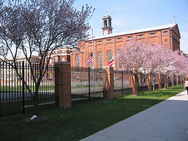Public officials choosing private schools: is it our business?

Gonzaga College High School, where one of Jack Evans’ kids goes. Photo by methTICALman on Flickr.
Several members of the DC Council don’t send their kids to public schools. Should voters care, or is it a private matter? These important private choices of public officials do tell us something about the beliefs of our elected leaders, but we shouldn’t read too much into them.
The Washington Examiner recently pointed out that Councilmembers Vincent Orange and Jack Evans send their kids to private schools.
Councilmember Phil Mendelson and Chairman Kwame Brown both send their kids to a DCPS school, Eaton Elementary, but it’s a short walk for Mendelson and a 9-mile drive for Brown, who is “out of boundary.” Harry Thomas, Jr. sends one child to private school and two to a public charter school.
Should we care?
As families lock in their school enrollment choices for the coming fall, education writers perennially “investigate” public officials’ choices of schools for their children, while public school defenders and detractors have at it. A recurring backlash to these stories asks whether any of this matters.
Is it an existential test of our leaders’ faith in public education? Is it a sign of the economic gaps between our leaders, who have choices and money for tuition and transportation, and the people they serve? Or is it a private issue about each child’s unique needs?
The question comes up when we elect a president with school-aged children. Perhaps the president’s children have special security concerns, and most don’t expect the First Family to be “regular people.” But we see articles about where lawmakers send their kids, like in Florida and Texas and even the U.S. Education Secretary. Here in DC, many expect their councilmembers to reflect their constituents.
The Examiner’s listing of the school each councilmember’s family chose for their children— private or public, charter or DCPS, out-of-boundary or a neighborhood school— suggests an implicit hierarchy of “common man” virtue, with a private school being the most elitist, and a neighborhood school, preferably one with low proficiency rates (the Examiner lists these), being the most virtuous.
Where public officials send their children to school may tell us something about their beliefs, but further investigation often leads people to ask intrusive questions about children’s needs and those questions should not be public matters. If CM Thomas has a child who wants more time in a baseball pitching rotation or had a preference for language immersion, is that important for us to know? What if his child were autistic or were being bullied?
Former Mayor Adrian Fenty and former Chancellor Michelle Rhee were each called out for sending their children to out-of-boundary DCPS schools, Lafayette ES and Oyster-Adams Bilingual ES, respectively. Was there any inconsistency between their public policies and private choices? In this case, not at all. In fact, exercising choice within the public school system is probably a good example to set, as long as they did not have any unfair advantages.
If they apply like anyone else and play by the rules, then they have a private duty to find the best school for their children, even while they work publicly to improve all schools for all children. If every parent tried to enroll their children in Lafayette or Oyster, then it would provide a useful signal that those schools may need to be expanded, or that those schools’ successful programs be replicated elsewhere.
If you want to be judgmental, the sharpest dividing line is between the public and private sectors. The public sector, which includes out-of-boundary and charter schools, is qualitatively distinct from the private sector. It is subject to stricter regulation and oversight. There is no tuition, and every child, regardless of family income, has the same right to attend, with applicants admitted by random drawing where demand exceeds supply.
Finally, transportation is an important factor in school choice that is rarely discussed in education debates. A neighborhood school is usually a walkable school. The farther parents send their kids, the more time is spent in transit, and more cars and buses crowd the roads.
But commutes to school might not be such a bad thing, even in a city like DC that aspires to good urbanism. The availability of school choice means that the choice of a school and the choice of a neighborhood do not have to be linked. This leaves greater possibilities for racial and social integration.
For example, the chairman of the city council can live east of the Anacostia River and still send his kids to schools in a more affluent part of town. Affluent residents of upper Northwest can send their children to an innovative charter school that is located in a transitional or poor neighborhood in Northeast. A blighted neighborhood can be more a attractive place for homeowners to invest if they have more school options than the one in the neighborhood.
Breaking the link between housing and schooling is one way to reduce segregation in housing, schooling, or both. Now to complete this utopian picture maybe Chairman Brown can leave the SUV at home and show his kids how to ride transit to school.
